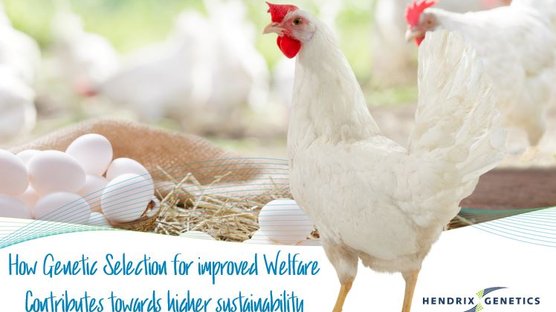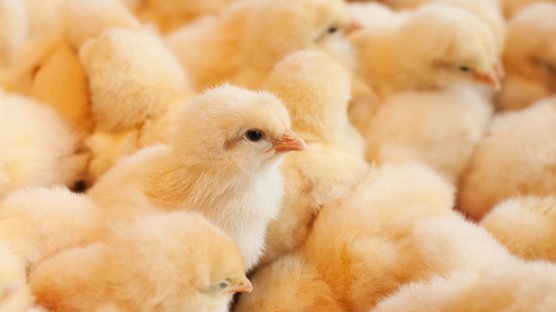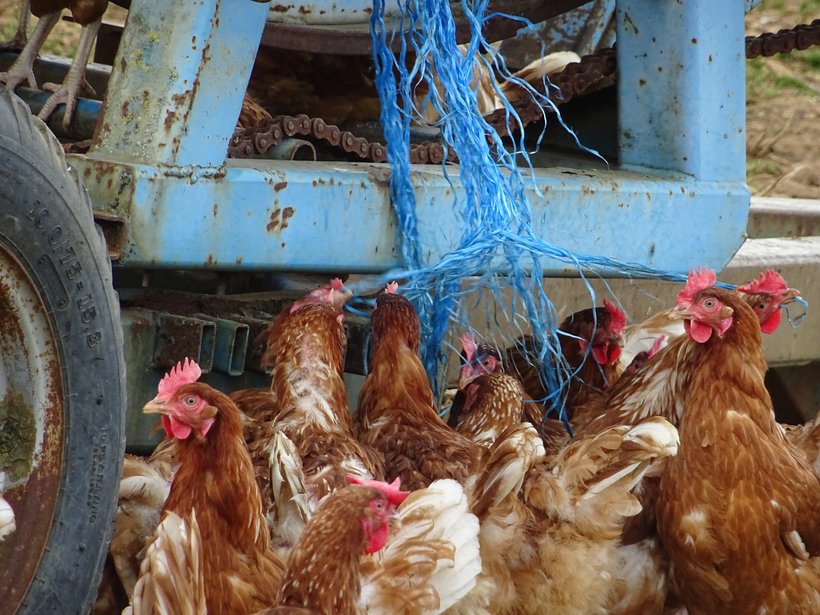
Published on March 4, 2022
Steering on bird behavior, Pecking
Individual chicken or flock behavior can be the result of individual factors, often it is a combination of multiple factors. In general, a laying hen can cope with moderate stress, such as rises or falls in temperature, transfer from the rearing barn to the laying facilities, or minor and gradual changes in the diet. It is important to recognize any significant change in the behavior of the flock, as the changes in behavior are good indicators of troubles within the flock.
The sooner a problem is detected, the easier it can be to overcome the problem and limit its’ impact. In this article we will discuss 1 of the most common behavioural problems that occur when keeping laying hens: pecking. We will explain the common risk factors involved, and we will come with easy to implement management practices that can help to avoid or overcome pecking.
Pecking
Feather pecking can become a major welfare problem in laying hens: severe feather pecking can result in severe feather damage, resulting in denuded body areas. These denuded body areas are more vulnerable for tissue pecking, wounding and, in more severe cases, mortality due to cannibalism or infected wounds. We should not forget that the feather cover is the first line of defense for laying hens. Next to feather pecking, pecking around the cloaca (also called vent pecking) can be one important cause of mortality. Vent pecking is often observed early in the laying period and towards the end of the laying period. Vent pecking is observed in both cage housings as in cage-free housing. In cage-free it mostly occurs when nests are too bright, or when the hens are producing floor or system eggs. Chickens are very curious by nature, and they can be triggered by the cloaca/egg production to think, “hey what’s that”. The wounds that are the result of the pecking, can trigger the birds again to peck at it, as it looks different/new to them. Good and timely management interventions can prevent excessive pecking behavior. Keep in mind that next to the economic losses of higher mortality, there are also economic losses related to feather cover as the loss of feather cover will lead in most cases to increased heat loss and consequently to higher feed consumption.
There are different kinds of pecking, in the eggs sector a distinguish is made between gentle pecking, which is considered as normal behavior or normal social interactions between laying hens, and severe pecking, which is considered to be abnormal behavior.
- Gentle pecking is defined as careful pecks, not resulting in feathers being pulled out and usually without reaction from the recipient bird. This is a form of social and explorative behavior. As brown egg layers are more curious compared to white egg layers, more of these social interactions between brown egg layers compared to white egg layers.
- Severe/injurious pecking is defined as forceful pecks, feathers are often being pulled out and you clearly can observe that the recipient hen is moving away, or she cringes. This form of severe/injurious pecking is clearly a form of aggressive behavior. This form of pecking often starts at the back, at the basis of the tail feathers. It also observed to start at the top of their heads and at their necks. When present at the neck, it is often misinterpret as being molting of the neck and neglected. You can distinguish molting versus pecking by looking closely to the feather loss, if you can observe true damage, it is most likely to be the result of pecking. Severe pecking can already start during the rearing period, it is known that poultry flocks that had to deal with feather pecking in the rearing period, are more likely to develop pecking during the productive life.
There can be stressful circumstances, which can result in this aggressive pecking behavior. You can often hear typical pain squawks of the chickens that are aggressively being pecked. It is extremely useful to take the time to listen to and to look at your flock. As this can help you in identifying changes in behavior sooner, allowing you to take more timely interventions. By forcing yourself to execute daily inspection rounds you will train yourself to listen to your flock, and to identify “what your flock is telling you”. Any abnormalities in behavior, movements, sounds, presence in the system (for cage-free), are indicators of a serious stress that is affecting your flock.
The most common causes of pecking are listed below:
- Parasitic infection: external (red mites, poultry lice) or worm infestations (Ascaridia, Capillaria)
- Enteritis and diarrhoea
- Inadequate ventilation, leading to high levels of humidity, dust or ammonia
- Drafts
- Non respect of density and equipment specifications
- Insufficient floor space, stress due to overcrowding
- Limited access to drinkers and feeders (insufficient number/ poor distribution)
- Difficulty to access nests, resulting in birds laying floor eggs that could results in pecking of exposed vents
- Shortage of water or feed
- Empty drinkers / feeders
- Water or feed unpalatable
- Too low pressure / leakage
- Improper ground connection of feeder and/or water equipment
- Poor beak treatment
- Feed not suitable
- Sodium deficiency
- Amino acids deficiency
- Lack of insoluble fiber
- Sudden change of feed particle size or feed ingredients
- Excessive energy level, leading to a reduction in bird’s feeding time
- Mistakes in the feed composition – like incorrect salt inclusion
- Light intensity too bright
- Light source too powerful
- Direct light from fluorescent bulbs (especially) or tubes, depending on the type.
- Entry of direct sunlight into the poultry house
- Flickering lightbulbs
- Too sudden increases in the duration of light
- Nests illuminated too bright– birds’ vents targeted during egg laying
"As pecking is difficult to control once it has started, the objective is to be ahead of the problem to prevent an outbreak. If it does occur (bearing in mind that it is indicative of abnormal behavior) the objective should be to identify the problem promptly and remedy the cause as quickly as possible."
If a pecking outbreak occurs, you need to react quickly:
- Try to decrease the light intensity. Take caution as the % of floor eggs could increase, and feed intake could be decreased
- When the lighting system allows, make use of the red LED light spectrum. Otherwise, you can paint the light bulbs in red or place red light covers over your TL’s.
- Add salt into the water (0.5-1Kg/1000l)
- Add extra vitamins / minerals / amino acids in water
- Add extra fiber sources within the house, like alfalfa or grain hulls
- Add enrichments within the house (pecking blocks, fiber bales, plastic bottles, plastic toys, Compact Discs, etc.). Make sure that the enrichments are compliant to local legislation and they are not harmful to the hens.
- Try to isolate the chickens that have been severely pecked (place them in an infirmary, sick pen), by removing them from the flock the remaining chickens will be less distracted by the different behavior of the affected chickens.
Preventive actions that can be taken to avoid pecking
Equipment
- It is advised to install a housing system that is creating different zones: zone to rest, a zone to lay eggs, a zone for dustbathing and foraging, zones for eating and drinking. This is easier in cage-free housing systems compared to cage housing, but enrichments in cage housing (nest compartments, perches, scratching areas) can limit the impact of pecking. These different zones will also allow the pecked hens to find a place to escape.
- Never overpopulate the chicken house, not in rearing, not in production. Allowing the birds sufficient space will give the birds less chances for negative counteractions, and there will be less competition for feeder and drinker space.
- When wintergardens are provided to the flock, try to make them attractive by installing drinkers, and to create lots of opportunities for dustbathing. Dustbathing is a social activity, it encourages positive social interactions, it stimulates a healthy feather cover, and it can help the birds to get rid of lice and mites.
- For free-range or organic flocks with outdoor access: provide plenty of opportunities for the chickens to shelter. Planting shrubs and trees will make the range more attractive, installing outdoor shelters will also provide the birds with a safe feeling. Try not to make the range attractive for predators as this can scare the chickens off from using the range intensively. Installing an electricity wire at the outside of the outer fence can scare off foxes, coyotes, racoons, cats, dogs, and any other unwanted visitors.
- During recent years, more information became available on the effects of lighting. LED lighting is strongly preferred. Daylight that enters the barn does not need to be a trigger for the flock to develop pecking. Many successful flocks have been reared and kept in production with natural daylight entering the barn. It is very important that the natural daylight is evenly spread when it enters the barn, it should not create big contrasts in regions that are very bright or that show a lot of shadow. Even light distribution is also important for all artificial light sources used, do not underestimate the impact of light on the behavior of chickens!
- If you’d like to be able to make use of the option to dim the lights in case of severe pecking, then it is advised to start off with bright lighting. This will allow you to use light dimming as an intervention method. The bright light will not harm the birds if no feather pecking occurs.
- Using the red color spectrum can help to lower the incidence of severe pecking, the red light will hide the differences in areas with or without feathers as well as the wounds. When you install new LED lighting, consider installing the LED’s where you can easily switch on the RED color spectrum.
- Make sure nests are attractive, and they are available in sufficient quantities. Always avoid too crowded nests. Hens need to have the time and space to feel comfortable when producing an egg. Competition between laying hens for nest space should be avoided. Well-designed attractive and clean nests, in sufficient availability, can reduce the incidence of floor eggs or system eggs. Don’t forget, laying hens producing eggs outside the nests are more prone to vent pecking.
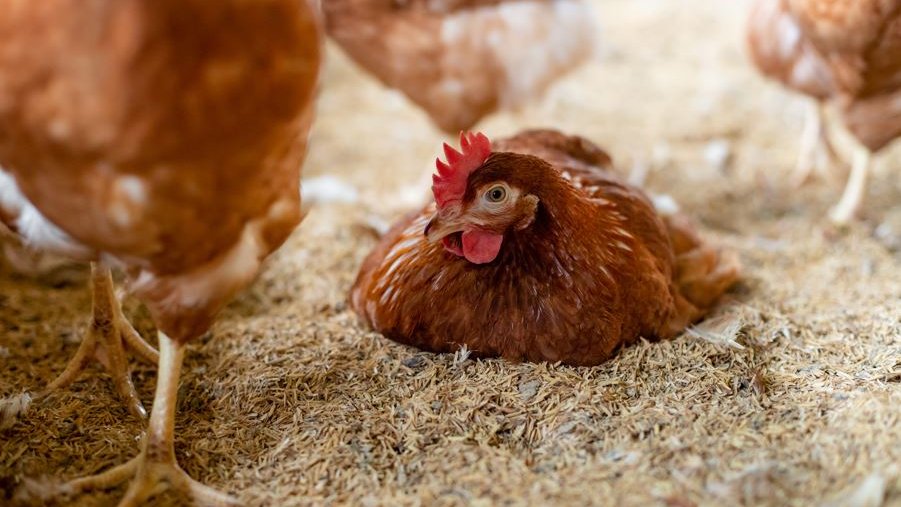
Climate
- A healthy, fresh, and well-balanced barn climate stimulates chick, pullet, and hen health in general. Ventilation is key as it can provide fresh air and stimulate a healthy climate (proper ventilation will reduce dust and ammonia levels). Always avoid draught, as this will have a negative impact on the barn climate.
- There is a higher chance to develop severe pecking under tropical, hot, and humid conditions. Laying hens and parent stock are better able to cope to colder, but dry climates, compared to hot and humid. Investing in good functioning climate control equipment will pay itself back overtime.
- When the chickens have access to litter, do keep an eye on your litter quality. Keep it dry and loose, remove caked litter as soon as possible, as it can negatively impact the climate inside the barn quickly.
Health Management
- A good biosecurity plan is absolute key for all chicken farmers, whether it is rearing, parent stock or production. Good biosecurity will result in a lower risk of pathogens entering the barns and affecting the flock. Main message: keep it clean! Remove dead birds as soon as possible, regularly check the system, the nests, or the cages for the presence of dead birds.
- Gut health is key: most flocks that show feather pecking or cannibalistic behavior have troubles related to gut health. Adding acidifiers to the drinking water can promote gut health. Providing alfalfa, grass or hay can also have a positive impact on gut health. Always consult your nutritionist and poultry veterinarian to come up with a plan that is designed for your operations. Regularly check the acidity levels of the drinking water.
- It is known that worms have an impact on general bird health, including the development of feather pecking / cannibalism. Monitor the worm infection status of your flocks regularly, deworm always in consultation with your poultry veterinarian, as too frequent deworming can also activate feather pecking / cannibalism (it something can kill worms, it is most likely to also impact the microbiota /gut health of the chickens).
- The presence of both (red) mites and lice are directly linked to feather pecking and cannibalistic behavior. They cause stress to the hens, and this stress can result in feather pecking / cannibalism. Have a poultry mite / lice eradication program in place, again: prevention is often the cheapest and most effective method.
- It is advised to install a separate pen for injured/wounded birds, this will allow them the rest needed for recovery, and they won’t get the attention from the more curious birds. An infirmary is strongly advised for parent stock flocks. When you make use of an infirmary, the chickens have a better chance to survive and recover. It is also easier to treat the chickens.
Feed Management
- Feeding techniques can be used to distract the birds from pecking each other. Supplying additional grain several times a day will keep the flock active, as something exciting is happening.
- Supplying coarse grains / coarse feed particles is promoting overall gut health, they take more time to digest resulting in a more “satisfied” feeling for the chickens.
- Adding grit, or oyster shell, will promote bird activity, and stimulated general health (including bone health)
- In case of cannibalism, extra salt can be temporarily (for a period of 1 week) added to the drinking water (0.5-1Kg of salt / 1000 liter of drinking water).
- The diets provided to the flocks should be well balanced: protein, fat, carbohydrates, minerals, and vitamins should all be present in the sufficient proportions. Fibers and coarse particle sizes have shown to stimulate general gut health, as mentioned earlier, chickens with a healthy gut have a lower chance to develop severe feather pecking or cannibalistic behavior. For a complete overview of all the recommendations we kindly refer to our nutrition management guide.
- The empty feeder technique is strongly advised, especially when birds with intact beaks are kept. The empty feeder technique will guarantee that there is no accumulation of the very fine particles, and it will prevent selective eating. The empty feeder technique stimulates also crop development and feed intake during the rearing period. For a full description of the empty feeder technique, we kindly refer to our nutrition management guide.
- Chickens cannot deal well with dietary disruptions, introduce dietary changes gradually as too big changes will cause stress to the chickens.
Overall Management
- Make sure that the chickens are used to human interactions and noises. This habituation process should already start during the rearing process. Visit your chicken flock frequently, so they know who you are. When you have technical visitors to your farm, make sure they wear farm coveralls, in a color they are used to (when they are used to blue coverall, and suddenly someone wearing a red coverall enters the barn, can cause panic/stress to the chickens. Installing a radio / radio boxes can help to train the chickens to get used to different sounds and can help in hiding background sounds.
- For Parent Stock, or certain organic poultry flocks, make sure the male to female ratio is well balanced already since the housing in the production barn. Spiking, replacing older males by younger males, can result in stress for the hens.
- There are many different options to distract the birds, often referred as enrichments. Think of pecking stones, pecking blocks, plastic bottles, big boxes, footballs, CD’s, straw ropes, big plastic toys (that they cannot ingest). These are just a few of many enrichments that can come at any costs.
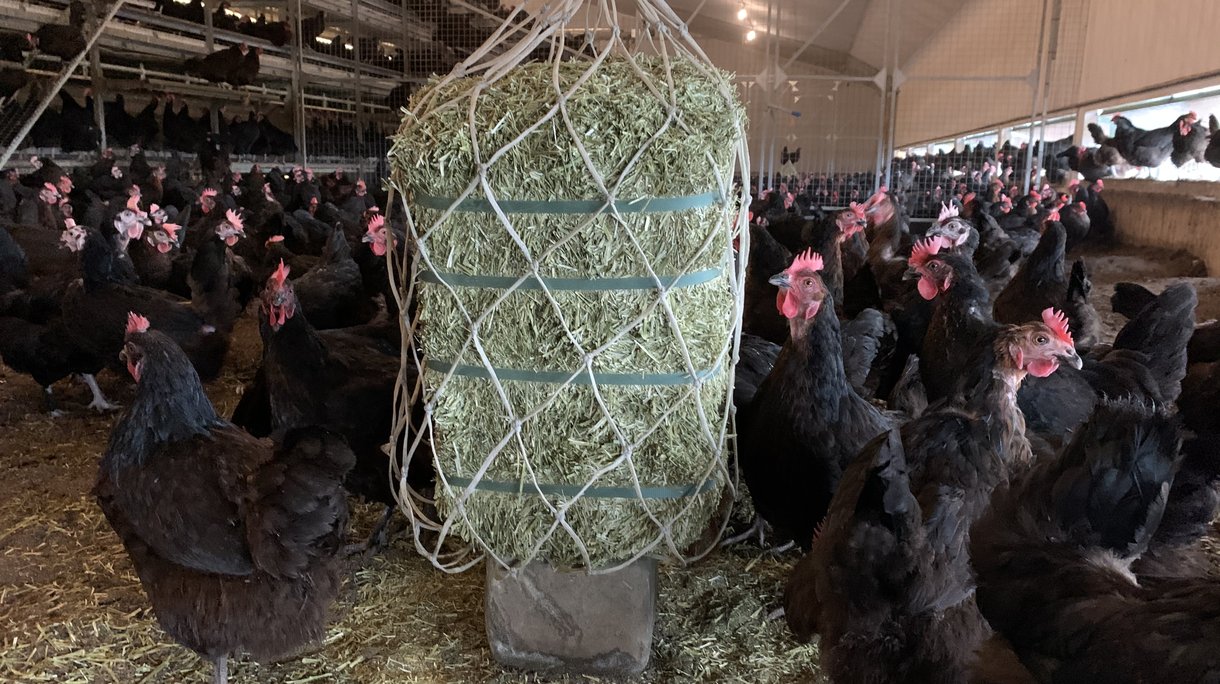
For Further Reading
- Emergency measures against feather pecking, Source [Lelystad] : Livestock Research Wageningen UR - p. Department(s) LR - Animal Behaviour & Welfare
LR - Animal Nutrition, WIAS Type of publication Research report Year of publication 2013 download the Dutch report, download the English report

